Europe Frozen Food Market Size
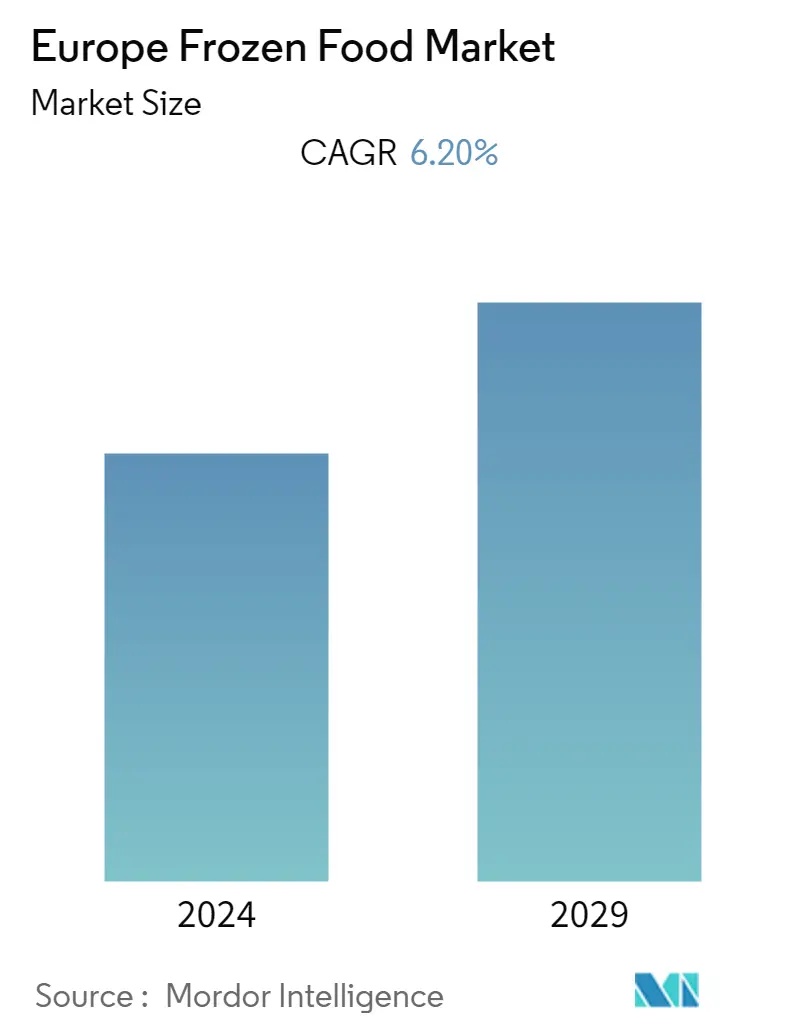
| Study Period | 2018 - 2029 |
| Base Year For Estimation | 2023 |
| Forecast Data Period | 2024 - 2029 |
| Historical Data Period | 2018 - 2022 |
| CAGR | 6.20 % |
| Market Concentration | Low |
Major Players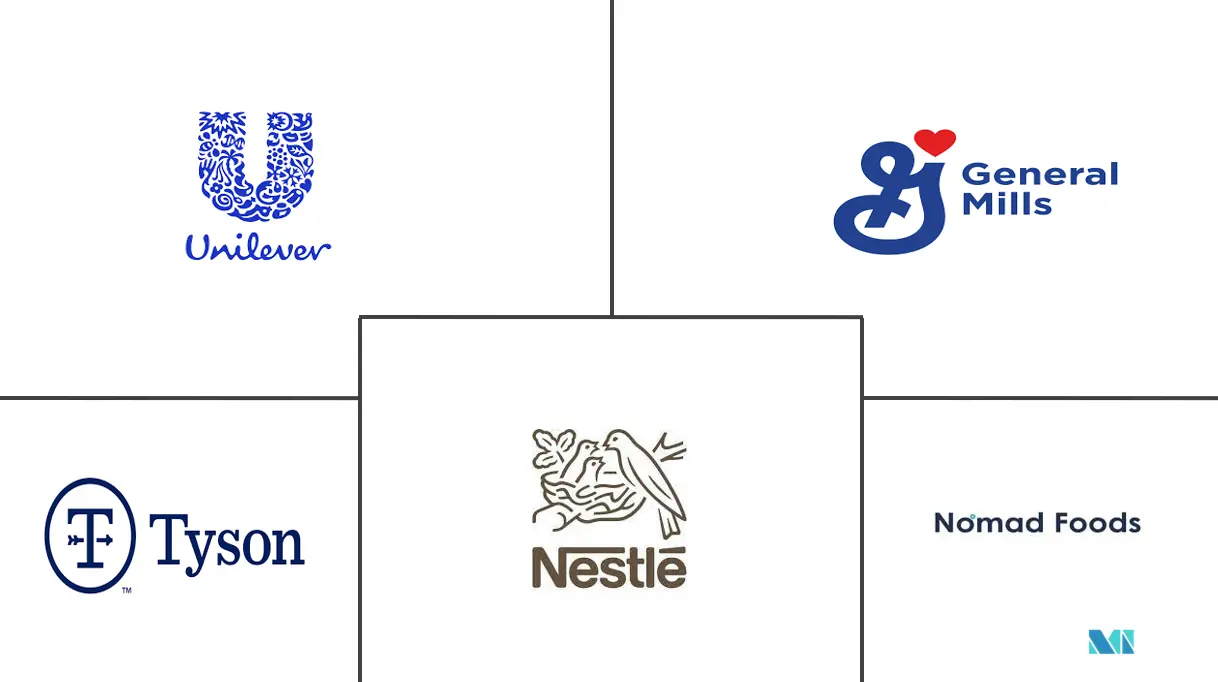
*Disclaimer: Major Players sorted in no particular order |
Europe Frozen Food Market Analysis
The European frozen food market is projected to register a CAGR of 6.2% over the next five years.
The region has witnessed a growing demand for frozen foods in recent years, owing to the busy lifestyles, changing dietary habits, and increasing disposable income of households. The fast urbanization of certain countries, such as Germany, the Netherlands, and others, has increased the demand for convenience foods like frozen foods, as these can be prepared in less time and stored for a longer period. Additionally, the government's focus on reducing food waste is adding leverage to the frozen food market in some countries. According to a report by the European Commission, household food waste generated in 2020 averaged 31 kilograms per person, and "out-of-home" food waste totaled 0.75 kilograms per person. Most of this waste is produced during the distribution and consumption phases. Because frozen goods have such a long shelf life, they naturally decrease waste across the supply chain, in stores, and at the consumer level.
Moreover, eco-conscious consumers in the region are also interested in new trends in the frozen food market, like clean-label and plant-based frozen foods, owing to the rising veganism in the country. This, in turn, has led the manufacturers to strategize their product offerings to include plant-based food items for the emerging vegan consumer base. In line with this, in April 2021, Aviko and Eurofrits launched a joint venture, namely, NeWind Foods in Spain, to incorporate the production of plant-based frozen food for domestic as well as international consumers.
Europe Frozen Food Market Trends
This section covers the major market trends shaping the Europe Frozen Food Market according to our research experts:
Increasing Demand for Convenience Food
The busy lifestyle of European consumers is driving the demand for convenience food as they are looking for on-the-go snacks and meals in their daily diet. According to the statistics of the European Union, the accumulative share of the employed population involved in different types of work either from home or from different offices has witnessed an increase from 14.6% to 24.4% between 2019 and 2021. Further, due to the work pressure consumers are not able to invest their time in the preparation of food on daily basis, thereby, preferring frozen ready meals as it reduces the time to cook. Thus, working individuals demand ready-to-cook products like diced frozen vegetables and frozen pastes, making the cooking process convenient. Additionally, the demand for frozen snacks is also increasing, owing to their longer shelf life and easy storage properties. As a result, key brands are offering products in line with customer sentiments to gain a competitive advantage. For instance, in June 2021, McCain launched the Pickers range in the frozen appetizer category in France. The Pickers by McCain range includes products such as Mini Mozzarella Sticks, Crispy Onion Rings, Cheesy Italian Pops, and Nachos Cheese Triangles. Therefore, the convenience factor has influenced consumer preference for frozen food products. Thus, the aforesaid factors are expected to propel the market's growth.
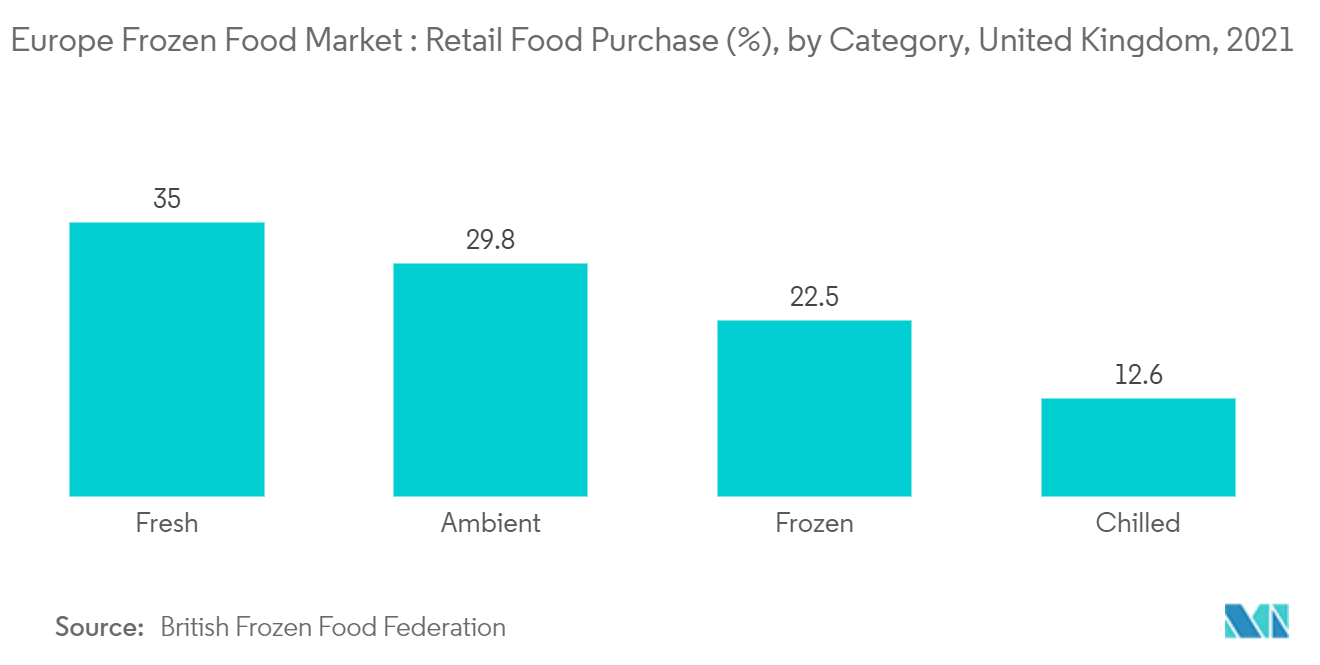
United Kingdom Dominates the Frozen Food Market in Europe
High consumer demand for frozen snacks, supported by the widespread availability of both private label and global brands across the distribution channels, is driving the growth of frozen food in the United Kingdom. In addition, families and younger consumers are opting for affordable, healthy options in the frozen food category with a longer shelf life. Further, the players in the market are focused on offering child-centric frozen food to expand their customer base. For instance, Ella's Kitchen, a leading baby food brand in the United Kingdom, offered its first-ever frozen food range for kids aged from weaning to three years. The products include toddler snacks and finger foods like sticks and puffs. Furthermore, growing health consciousness among consumers is anticipated to accelerate the demand for vegetarian and free-from foods like gluten-free, low-sodium, etc. Thus, companies are innovating new alternatives to cater to evolving consumer preferences. For instance, in December 2020, Aviko launched three new frozen potato products. The new frozen potato snack includes Super Crunch Julienne Fries, Bistro Garlic and Herb Wedges, and Mashed Potato. The company claims that these products are gluten-free and vegetarian-friendly.
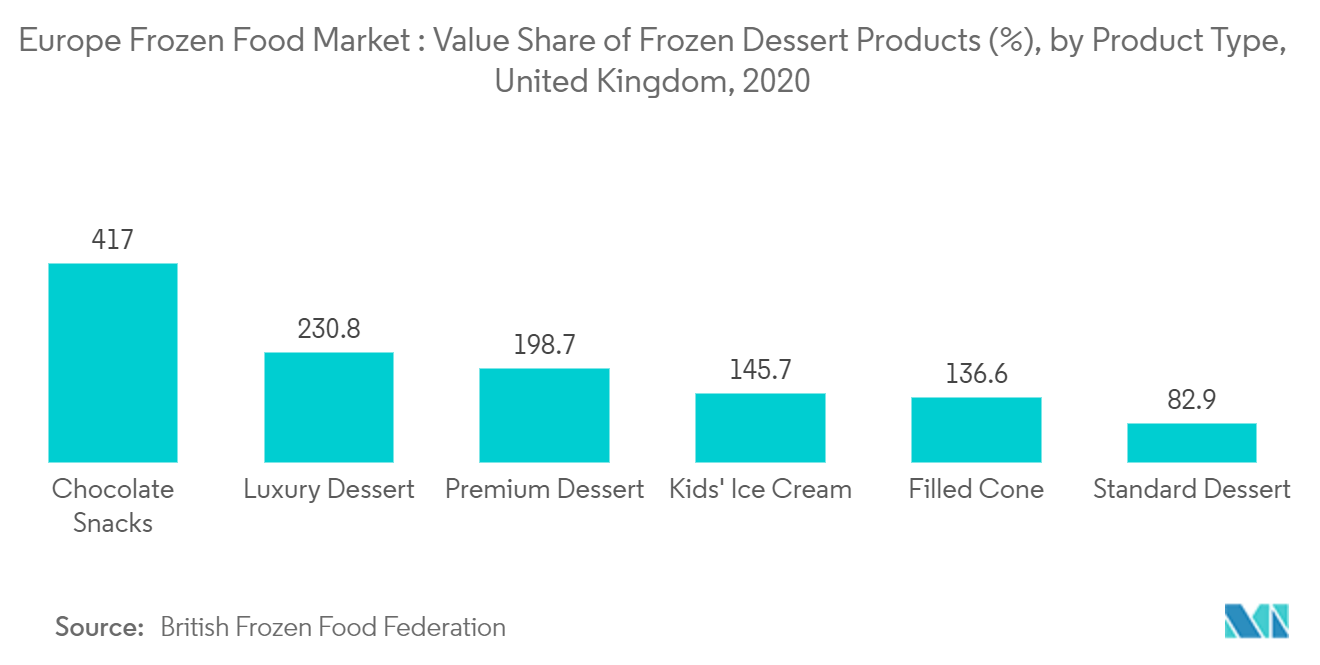
Europe Frozen Food Industry Overview
The frozen food market in Europe is highly competitive, with the presence of global as well as regional players. The existence of global players is boosting the competition for local operators in the region. Alongside this, the players are focused on sustaining their position in the market, focusing majorly on expanding their businesses and uplifting the brand image. To promote their respective businesses, these players are adopting product innovation and expansion as their key strategies. Some of these key players include General Mills Inc., Unilever Plc, Nestle SA, Tyson Foods Inc., and Nomad Foods Ltd, among others. The key players in the market are catering to both online and offline retail channels in order to expand their reach in the market. For instance, in May 2021, Iceland and The Food Warehouse launched a Del Monte Frozen Fruit range across offline stores and online platforms.
Europe Frozen Food Market Leaders
-
Tyson Foods, Inc.
-
Nestle SA
-
Unilever PLC
-
General Mills Inc.
-
Nomad Foods Europe Limited
*Disclaimer: Major Players sorted in no particular order
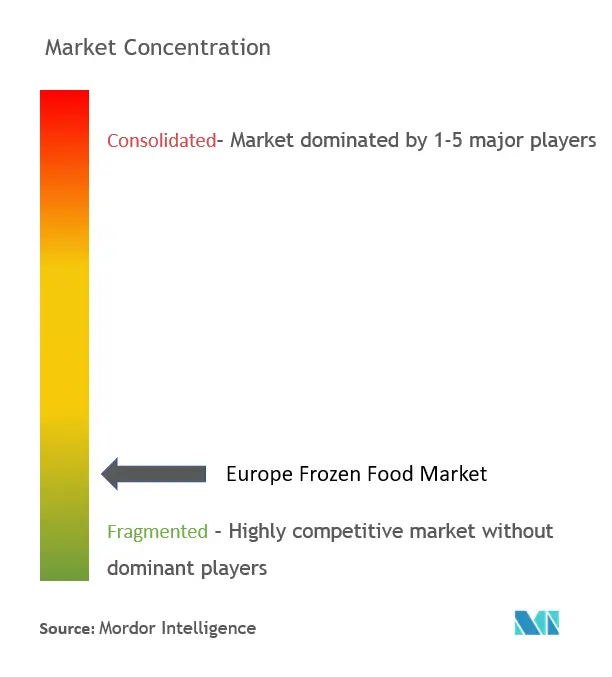
Europe Frozen Food Market News
- August 2022: Yogurtland expanded its business by launching a new limited-edition Watermelon Sorbet crafted with Sour Patch Kids Candy taste.
- June 2022: THIS, a plant-based food brand in the United Kingdom, expanded its presence in the frozen food sector by launching plant-based frozen food, THIS Isn't Chicken Tenders, THIS Isn't Pork Sausages, and THIS Isn't Chicken Nuggets. The products are made available in Sainsbury stores across the United Kingdom.
- September 2021: Nomad Foods Limited completed its previously announced acquisition of Fortenova Group's frozen food business (Fortenova Frozen) for approximately EUR 615 million.
Europe Frozen Food Market Report - Table of Contents
1. INTRODUCTION
1.1 Study Assumptions and Market Definition
1.2 Scope of the Study
2. RESEARCH METHODOLOGY
3. EXECUTIVE SUMMARY
4. MARKET DYNAMICS
4.1 Market Drivers
4.2 Market Restraints
4.3 Porter's Five Force Analysis
4.3.1 Threat of New Entrants
4.3.2 Bargaining Power of Buyers/Consumers
4.3.3 Bargaining Power of Suppliers
4.3.4 Threat of Substitute Products
4.3.5 Intensity of Competitive Rivalry
5. MARKET SEGMENTATION
5.1 By Products Category
5.1.1 Ready-to-Eat
5.1.2 Ready-to-Cook
5.1.3 Other Product Categories
5.2 By Product Type
5.2.1 Frozen Fruits and Vegetables
5.2.2 Frozen Meat and Fish
5.2.3 Frozen-cooked Ready Meals
5.2.4 Frozen Desserts
5.2.5 Frozen Snacks
5.2.6 Other Product Types
5.3 By Distibution Channel
5.3.1 Supermarkets/Hypermarkets
5.3.2 Convenience Stores
5.3.3 Online Stores
5.3.4 Other Distribution Channels
5.4 By Geography
5.4.1 Spain
5.4.2 United Kingdom
5.4.3 Germany
5.4.4 France
5.4.5 Italy
5.4.6 Russia
5.4.7 Rest of Europe
6. COMPETITIVE LANDSCAPE
6.1 Most Adopted Strategies
6.2 Market Share Analysis
6.3 Company Profiles
6.3.1 General Mills Inc.
6.3.2 Unilever
6.3.3 Nestle SA
6.3.4 Tyson Foods Inc.
6.3.5 Nomad Foods Ltd
6.3.6 Ajinomoto Co. Inc.
6.3.7 Conagra Brands Inc.
6.3.8 BEST FOOD S.C.
6.3.9 Falken Trade GmbH
6.3.10 FZ Foods AG
- *List Not Exhaustive
7. MARKET OPPORTUNITIES AND FUTURE TRENDS
8. IMPACT OF COVID-19 ON THE MARKET
9. DISCLAIMER
Europe Frozen Food Industry Segmentation
Frozen food products refer to packaged food that is subjected to rapid freezing and is kept frozen until used. The frozen food market in Europe is segmented by product category, product type, distribution channel, and geography. By product category, the market is bifurcated into ready-to-eat, ready-to-cook, and other product categories. By product type, the market is segmented into frozen fruits and vegetables, frozen meat and fish, frozen-cooked ready meals, frozen desserts, frozen snacks, and other product types. Based on distribution channels, the market is fragmented into supermarkets/hypermarkets, convenience stores, online channels, and other distribution channels. By geography, the market is segmented into Spain, Italy, the United Kingdom, Germany, France, Russia, and the Rest of Europe. For each segment, the market sizing and forecasts have been done on the basis of value (in USD million).
| By Products Category | |
| Ready-to-Eat | |
| Ready-to-Cook | |
| Other Product Categories |
| By Product Type | |
| Frozen Fruits and Vegetables | |
| Frozen Meat and Fish | |
| Frozen-cooked Ready Meals | |
| Frozen Desserts | |
| Frozen Snacks | |
| Other Product Types |
| By Distibution Channel | |
| Supermarkets/Hypermarkets | |
| Convenience Stores | |
| Online Stores | |
| Other Distribution Channels |
| By Geography | |
| Spain | |
| United Kingdom | |
| Germany | |
| France | |
| Italy | |
| Russia | |
| Rest of Europe |
Europe Frozen Food Market Research FAQs
What is the current Europe Frozen Food Market size?
The Europe Frozen Food Market is projected to register a CAGR of 6.20% during the forecast period (2024-2029)
Who are the key players in Europe Frozen Food Market?
Tyson Foods, Inc., Nestle SA, Unilever PLC, General Mills Inc. and Nomad Foods Europe Limited are the major companies operating in the Europe Frozen Food Market.
What years does this Europe Frozen Food Market cover?
The report covers the Europe Frozen Food Market historical market size for years: 2018, 2019, 2020, 2021, 2022 and 2023. The report also forecasts the Europe Frozen Food Market size for years: 2024, 2025, 2026, 2027, 2028 and 2029.
What are the top growth trends in the European Frozen Food Market?
The top growth trends in the European Frozen Food Market are a) Convenience b) Innovation c) Premiumization
Europe Frozen Food Industry Report
The Europe frozen food market has seen remarkable growth, fueled by changing lifestyles, dietary preferences, and an increasing demand for convenience. Countries like Germany, France, and the UK are at the forefront, with a diverse range of products from ready meals to seafood catering to both convenience seekers and health-conscious consumers. Innovations, including plant-based and diet-specific options, alongside a surge in veganism, are propelling the market forward. Economic stability, urban income growth, and evolving culinary practices have cemented frozen foods as a staple in European diets, valued for their convenience, cost-effectiveness, and long shelf life. According to Mordor Intelligence™ Industry Reports, the market is experiencing significant share, size, and revenue growth, with detailed analysis and forecasts available in their comprehensive report. This report offers a historical overview and a future outlook, highlighting the dynamic nature of the Europe frozen food market. Get a free PDF sample of this insightful industry analysis to understand the trends shaping the future of frozen foods in Europe.



